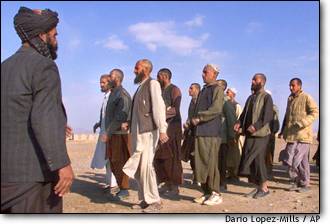|
|||||||||||||||||||||||||||
Finally, in frustration, he shouted, “Go away!”
Scenes on the army’s dusty grounds and newly appropriated al-Qaida training camps are as comic as any “You’re In the Army Now” film ever made. Afghan veterans run through the basics with the crop of recruits showing up each day at the gates.
Told to face left, young men swing wildly right, left, and right again. Marching resembles out-of-synch shuffling. Unfamiliar barked commands like “Hut!” draw giggles from the ranks, and shivering recruits have to be coaxed out of their turbans and beaded caps in the cold.
But the purpose is serious, the soldiers say: nothing less than life, and the life of their reborn nation.
“I want to work for my country. I want to work for peace,” said 12-year-old Abdul Rawoof, who left a full-time job as a mechanic to enlist at a training ground outside Kandahar. Afghanistan has been at war for twice as long as the boy has been alive.

SECOND TIME AROUND
Afghanistan’s last attempt at a coalition government, in the 1990s, fell apart in a civil war by rival warlords, opening the way for the Taliban and their al-Qaida allies.
“It would have been possible to stop the war back then, if there had been a real national army. But there was no army,” said Tour Ahmad Ullah, 50, who served in the army of King Mohammad Zaher Shah, deposed three decades ago.
Another soldier, Ahman Ullah, still has his identity card from his days in the royal army in the 1970s: a yellow laminated slip showing him as a clean-cut, mustached 22-year-old in dark uniform.
|
|||||||||||||||||||||||||||||||||||||||||||||||||||||||||||||||||||||||||||||
“They’re new,” he said, after Tour Ahmad Ullah released the faltering boy in the rabbit-fur jacket. “Then you will see.”
The recruits are paid in food, for now — tomatoes and potatoes. But even that is in arrears, hungry soldiers say.
In a country where every man seems to have an AK-47 stashed somewhere, arms for training at Kandahar consist of a few rifles and a dirty anti-tank weapon — less than the stash of any Afghan foxhole during the fighting against the Taliban.
Even though Kandahar province is collecting thousands of arms from warlords — from rifles to artillery — the recruits training here are not ready for them, Tour Ahmad Ullah said.
THREATS REMAIN
In Kandahar, in fact, the army can seem as much an exercise in disarming as arming.
Faced with a rebellious tribal leader on the province’s border with Pakistan, Agha — monitored by U.S. forces in the field — ousted him and brought 700 of the leader’s men to Kandahar.

|
|||||||||||||||||||||
 Afghan warlords threaten stability
Afghan warlords threaten stabilityThe biggest single threat to Afghanistan now, Pashtun said, is “outside interference from our neighbors — Iran and Pakistan immediately, but also Russia.”
A little more than a month into the new government’s regime, it’s unclear whether the forces being trained here are anything more than a show for the outside world or future militias for local warlords.
But commanders here insist otherwise: They are readying elements of a national army, to be melded after training with fellow Afghan soldiers from Herat to Kabul.
“Uzbek. Pashtun. Hazara,” Tour Ahmad Ullah says, ticking off Afghanistan’s ethnic groups on his fingers, before folding them into a fist.
“They will work as one.”

 |
||||||||||||||||||||||||||||||||||||||||||||||||||||||||||||||||||||||||||||||||||||||||||||||||||||||||||||||||||||||||||||||||||||||||||||||||||||||||||||
|
||||||||||||||||||||||||||||||||||||||||||||||||||||||||||||||||||||||||||||||||||||||||||||||||||||||||||||||||||||||||||||||||||||||||||||||||||||||||||||
 |
||||||||||||||||||||||||||||||||||||||||||||||||||||||||||||||||||||||||||||||||||||||||||||||||||||||||||||||||||||||||||||||||||||||||||||||||||||||||||||

